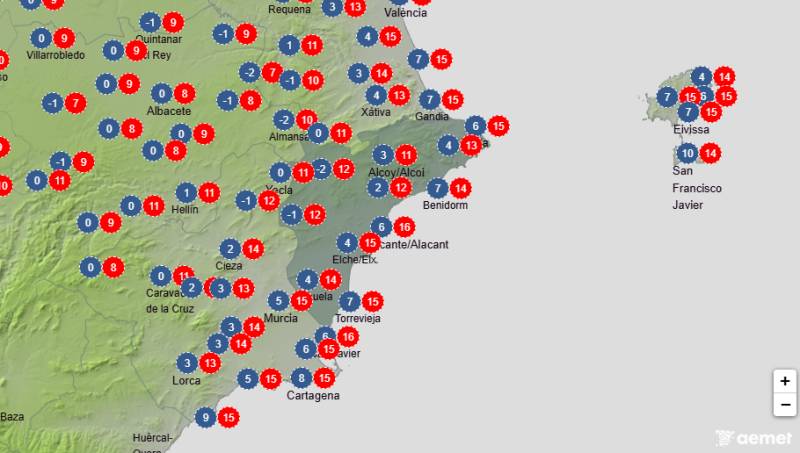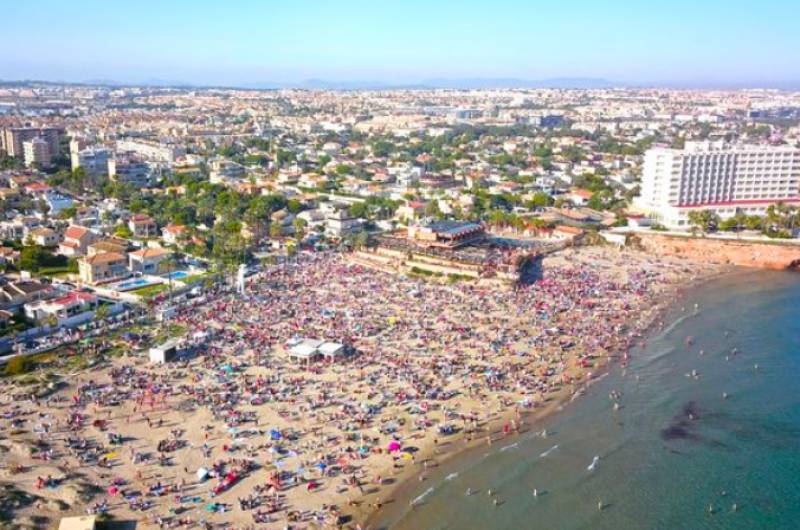- Region
- Águilas
- Alhama de Murcia
- Jumilla
- Lorca
- Los Alcázares
- Mazarrón
- San Javier
-
ALL AREAS & TOWNS
- AREAS
- SOUTH WEST
- MAR MENOR
- MURCIA CITY & CENTRAL
- NORTH & NORTH WEST
- TOWNS
- Abanilla
- Abarán
- Aguilas
- Alamillo
- Alcantarilla
- Aledo
- Alhama de Murcia
- Archena
- Balsicas
- Blanca
- Bolnuevo
- Bullas
- Cañadas del Romero
- Cabo de Palos
- Calasparra
- Camping Bolnuevo
- Campo De Ricote
- Camposol
- Canada De La Lena
- Caravaca de la Cruz
- Cartagena
- Cehegin
- Ceuti
- Cieza
- Condado de Alhama
- Corvera
- Costa Cálida
- Cuevas De Almanzora
- Cuevas de Reyllo
- El Carmoli
- El Mojon
- El Molino (Puerto Lumbreras)
- El Pareton / Cantareros
- El Raso
- El Valle Golf Resort
- Fortuna
- Fuente Alamo
- Hacienda del Alamo Golf Resort
- Hacienda Riquelme Golf Resort
- Isla Plana
- Islas Menores & Mar de Cristal
- Jumilla
- La Azohia
- La Charca
- La Manga Club
- La Manga del Mar Menor
- La Pinilla
- La Puebla
- La Torre
- La Torre Golf Resort
- La Unión
- Las Palas
- Las Ramblas
- Las Ramblas Golf
- Las Torres de Cotillas
- Leiva
- Librilla
- Lo Pagan
- Lo Santiago
- Lorca
- Lorquí
- Los Alcázares
- Los Balcones
- Los Belones
- Los Canovas
- Los Nietos
- Los Perez (Tallante)
- Los Urrutias
- Los Ventorrillos
- Mar De Cristal
- Mar Menor
- Mar Menor Golf Resort
- Mazarrón
- Mazarrón Country Club
- Molina de Segura
- Moratalla
- Mula
- Murcia City
- Murcia Property
- Pareton
- Peraleja Golf Resort
- Perin
- Pilar de la Horadada
- Pinar de Campoverde
- Pinoso
- Playa Honda
- Playa Honda / Playa Paraíso
- Pliego
- Portmán
- Pozo Estrecho
- Puerto de Mazarrón
- Puerto Lumbreras
- Puntas De Calnegre
- Region of Murcia
- Ricote
- Roda Golf Resort
- Roldan
- Roldan and Lo Ferro
- San Javier
- San Pedro del Pinatar
- Santiago de la Ribera
- Sierra Espuña
- Sucina
- Tallante
- Terrazas de la Torre Golf Resort
- Torre Pacheco
- Totana
- What's On Weekly Bulletin
- Yecla


- EDITIONS:
 Spanish News Today
Spanish News Today
 Alicante Today
Alicante Today
 Andalucia Today
Andalucia Today
El Barrio de Santa Cruz in Alicante City
One of the oldest parts of Alicante City, famous for its colourful houses and narrow streets
The barrio de Santa Cruz is a large area encompassing all of the old quarter of the city of Alicante. However, in tourist guides, when people talk about the Barrio de Santa Cruz they tend to refer to the main residential area on the highest point of the barrio, sitting on the slopes on the South-West side of Mount Benacantil. This area was built before all of the modern tower blocks went up all over the city, and has maintained its antique charm and character due to the elevated slopes that have meant that the old, small houses haven’t been demolished.
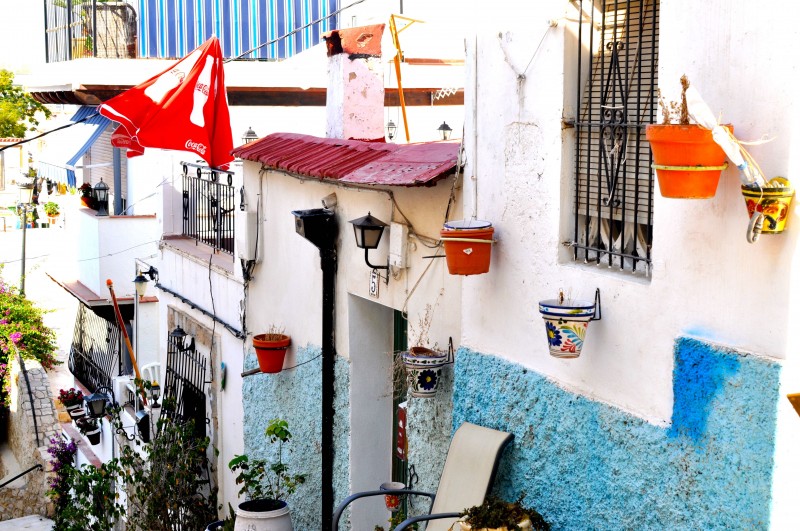
It is a pedestrian area only as the narrow streets were built before motor vehicles existed, and with its hilly terrain the area contrasts greatly with the rest of the modernised, urban parts of Alicante city. In fact the area gives visitors the impression of being in a separate small town in the countryside rather than in a barrio just minutes away from the bustling city port and La Rambla Méndez Núñez.
The most visited and photographed streets are Calle San Rafael and Calle San Antonio, owing to their colourful painted houses, whitewashed walls and rows of decorative flowers in pots, giving each home a unique appearance. During the day visitors can see locals sitting outside on their porches basking in the sun with their pets whilst children play games with their neighbours along the streets. It is great to visit this place at lunchtime when everyone has their front doors open allowing the streets to be filled with delicious smells of the different meals that are being cooked inside the houses. Calle San Rafael can also be particularly lively in the evenings as locals tend to gather together here with family and friends to eat dinner and sing on the terrazas of the small restaurants serving typical Alicante cuisine.
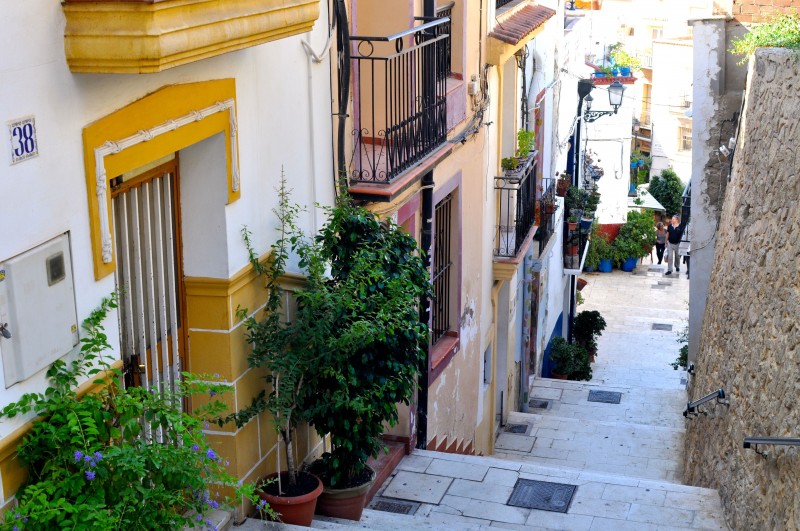
The streets can be accessed on foot from La Rambla de Méndez Núñez by taking a left turn onto Plaza de San Cristobal, and then continuing onto Calle Argensola (visitors travelling by car can park in the underground carpark located at the entrance to Plaza de San Cristobal). At the end of Calle Argensola is Plaza de Carmen, and up the plaza steps is the entrance to Calle San Rafael. Further up San Rafael on the left is Calle San Antonio, and at the highest point of Calle San Rafael is an entrance to the Parque de la Ereta.
From the start of Calle San Antonio there are blue clearly- marked sign posts leading to La Ermita de Santa Cruz, a chapel dating back to the 18th Century, topped with a tower called La Torre de la Ampolla, one of the few medieval monuments that remain intact along the mountain slopes. Next to the chapel is a viewing point from which visitors can see stunning views of the city, the port and the sea. The chapel is also the starting point for the Hermandad de la Santa Cruz processions that take place during Semana Santa (Holy week).
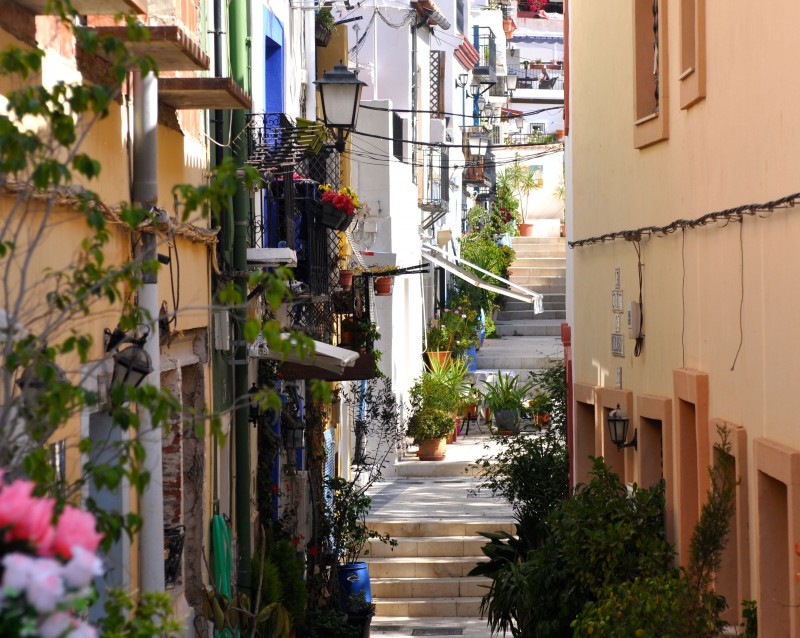
In addition to the blue sign posts, there are a number of interesting plaques dotted around on different street walls in the area, on which are small verses of poetry about the barrio or messages telling the journey of the 'costaleros' (float bearers) who carry on their shoulders the 'pasos' (religious statues) representing scenes of the Passion of Christ during the Holy Week Processions. Accompanying some of the plaques are also small paintings or figures representing Jesus carrying the cross before the crucifiction.This is a Vía Crucis and prior to the Semana Santa celebrations members of the brotherhood will follow the route in an act of worship, stopping off at each of the stations of the cross for a reading and a prayer.
If visitors have time to explore further, then the next stop would be the tiny Barrio de San Roque, which can be accessed from Plaza de Carmen by taking a left turn onto Calle de Toledo and following the street round. This barrio is home to a few more narrow streets with flowers and colourfully painted houses as well as the oldest chapel in Alicante, La Ermita de San Roque. Along some of the walls in this area are colourful murals with lines of poetry, and with the odd taberna, quirky café and antique art shop dotted along Calle de Toledo, this area feels very authentically Spanish.
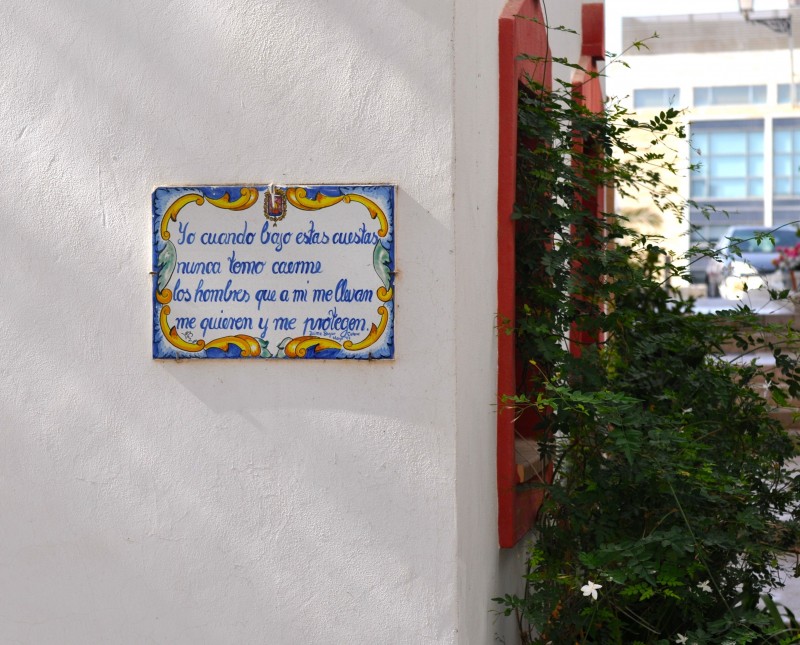
Visitors should note that the hilly areas of Santa Cruz and San Roque are only accesible via steps, and are therefore unsuitable for people with reduced mobility. People wishing to explore these areas are advised to wear comfortable footwear and bring a bottle of water, as although it doesn't take long at all to climb up to the main points of interest, the steepness and heat may make the walk seem more challenging for some. However, the steep steps shouldn't put people off visiting some of the oldest and most beautiful parts of the city of Alicante.
Click here for more information about visiting the City of Alicante, including what's on and where to go: Click for the dedicated Alicante City section
















